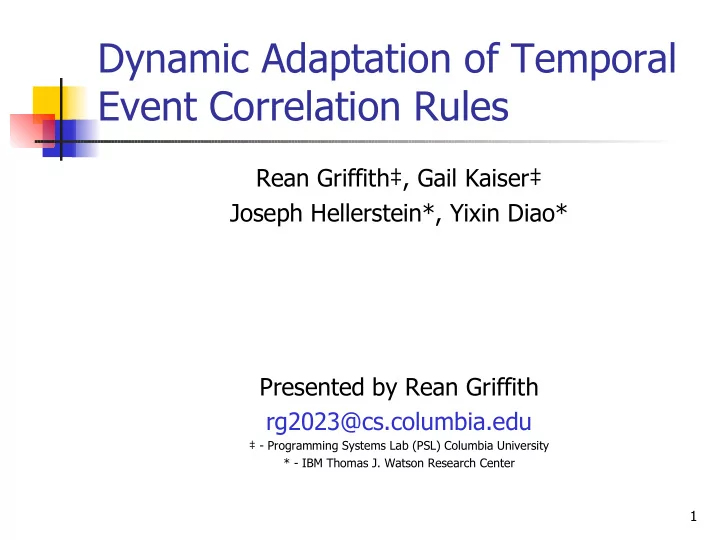

Dynamic Adaptation of Temporal Event Correlation Rules Rean Griffith‡, Gail Kaiser‡ Joseph Hellerstein*, Yixin Diao* Presented by Rean Griffith rg2023@cs.columbia.edu ‡ - Programming Systems Lab (PSL) Columbia University * - IBM Thomas J. Watson Research Center 1
Overview Introduction Problem Solution System Architecture How it works – Feed-forward control Experiments Results I, II, III Conclusions & Future work 2
Introduction Temporal event correlation is essential to realizing self-managing distributed systems. For example, correlating multiple event streams from multiple event sources to detect: System health/live-ness Processing delays in single/multi-machine systems Denial of service attacks Anomalous application/machine-behavior 3
Problem Time-bounds that guide event stream analysis are usually fixed. Based on “guesstimates” that ignore dynamic changes in the operating environment Fixed time-bounds may result in false-alarms that distract administrators from responding to real problems. Issues with client-side timestamps (even with clock synchronization). 4
Solution Use time-bounds as the basis for temporal rules, but introduce an element of “fuzz” based on detected changes in the operating environment. To detect changes in the operating environment introduce Calibration Event Generators which generate sequences of events (Calibration frames) at a known resolution. Use the difference in the arrival times of calibration events to determine the “fuzz” to use. Only time-stamps at the receiver count. 5
System Architecture 6
How it works – Feed-forward Control Use the difference in the arrival times of calibration events within a calibration frame (less the generator resolution) as an observation of “propagation skew”. Record last N observations of propagation skew. Sort these observations and use the median as the “fuzz” to add to timer rules Using the median prevents overreaction to transient spikes. 7
Experiments Linux 2.6 Linux 2.6 Windows XP Linux 2.6 SP2, 3GHz, 3GHz, 1GB 3GHz, 1GB 3GHz, 1GB 1GB RAM RAM RAM RAM Configuration A Calibration Siena Event Event Distiller N/A 3-machine Event Router Generator Configuration B Calibration Siena Event N/A Event Distiller 3-machine Event Router Generator Configuration C Calibration N/A Siena Event N/A Event Router + 2-machine Generator Event Distiller Configuration D Calibration Siena Event N/A N/A Event Router + 2-machine Generator Event Distiller 8
Results I – Propagation Skews 3-machine 2-machine Windows + Linux All Linux 9
Results II - Autocorrelations B A 3-machine C D 2-machine Windows + Linux All Linux 10
Results III – Sensitivity to N (Run 3 Configuration C) Most accurate N (observation window size) depends on: Actual conditions AND initial fuzz factor setting Generator set to produce 241/445 “real” failures With large N we use initial fuzz factor longer, erroneously reporting fewer “real failures” (when we’re missing real problems) Initial fuzz factor setting = 0 ms Initial fuzz factor setting = 500 ms 85%-90% accuracy with smaller N 80%+ accuracy with smaller N. 1 0 . 9 0 . 9 5 0 . 8 0 . 9 0 . 7 0 . 8 5 0 . 6 0 . 8 0 . 5 0 . 7 5 0 . 4 0 . 7 0 . 3 0 . 6 5 0 . 2 0 . 6 0 . 1 0 . 5 5 11 0 . 5 0 0 5 0 1 0 0 1 5 0 2 0 0 2 5 0 3 0 0 3 5 0 4 0 0 4 5 0 0 5 0 1 0 0 1 5 0 2 0 0 2 5 0 3 0 0 3 5 0 4 0 0 4 5 0
Conclusions There is more to our notion of “propagation skew” than network delays. Resource contention at the receiver on certain platforms as seen in configuration C (2-machine Linux + Windows setups) also affects our observations. Near optimal settings automatically achieved by managing the tradeoff between larger observation windows and the ability to respond quickly to changes in the environment. Feed-forward control useful in building self-regulating systems that rely on temporal event correlation. 12
Comments, Questions, Queries Thank you for your time and attention. Contact: Rean Griffith rg2023@cs.columbia.edu 13
Event Package Events Represented as Siena Notifications of size ~80 bytes 14
Recommend
More recommend